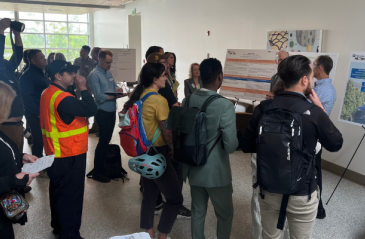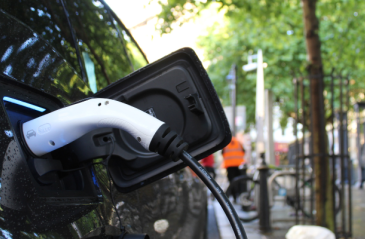
The information barriers holding back climate action and how to break them

Estonia's cutting edge use of digital technology has won admirers from near and far
Share articleFormer Estonian PM @TaaviRoivas says digital technology has given his country a new reputation
Share articleEstonians have a digital identity that enables them to access govt and private sector services
Share articleWe put our vision for government into practice through learning partner projects that align with our values and help reimagine government so that it works for everyone.
For such a small country - it only has 1.3 million citizens - Estonia has carved out for itself quite the global reputation among policymakers. But why do so many travel from near and far to its capital, Tallinn? What's the cause of this mass pilgrimage? The answers they seek lie in Estonia's cutting-edge deployment of digital technology.
The country's ability to tap into technological solutions has seen it establish itself as one of the world's most digitally advanced societies. Want an e-residency? No problem. Pay your taxes with one click? Of course. Keen for blockchain to store your personal health data? Right this way. (And these are just a few examples - there are plenty more.)
So how have they come so far, so fast? Taavi Rõivas, who served as the country's prime minister between 2014 and 2016, says that Estonia's ability to go digital is rooted in the fact that, after the restoration of independence in 1991, the country needed to build itself up from scratch - and fast.
“Located between neighbours that are much bigger, Estonia is a small fish in a huge global ocean,” he points out. “You're either slow and get eaten or you become very fast and develop the economy and the digital society - Estonia opted for the latter.”
Although technology today is a constant presence, it is important to remember that a mere 20 years ago the internet in many countries was only starting to edge its way into widespread use. Estonia, however, was already making strides. By 1997, 97 percent of its schools were online, and by 2002 a free wifi network had been established across most of the country.
Good internet connection, says Rõivas, is absolutely vital. “You also need to have internet everywhere, and whether it is broadband or 4G or 5G, inclusiveness is extremely important. There is a saying that education is the biggest equaliser in the world, and this is probably right. But I'm also sure that the internet and digital services are right behind. Once you have digital access to these services, it doesn't matter anymore where you live - everyone can access the services at the same time.”
The wifi network served to underpin Estonia's first moves to give each citizen a digital identity - which has since become the default method of identification. The chip on the card carries embedded files and, using secure encryption, it can be used as definitive proof of ID for citizens needing, for example, to travel elsewhere in the EU, or to log onto their bank account. It can also be used for digital signatures, e-prescriptions or to check medical records or submit tax returns - no wonder 98 percent of Estonians have one.
“As a citizen, I don't especially like to stand in line and wait for some sort of transaction,” says Rõivas. “We still have passports and physical ID cards, but whenever you need a service from the government, local municipality or private sector company, the default way of accessing this service is going online and logging in with your digital ID. It means that once you confirm who you are over the internet to government, municipality, bank or whatever, they can give you all the services you need that you would have previously needed your passport for. It's like going from cash-only to internet banking but so much bigger as it is not just money, it's every service.”
Since 2003, government services have been virtually all online. Citizens can log on to the e-Estonia State Portal, a one-stop shop for hundreds of e-services offered by government organisations. It means that a citizen can log on with their secure ID - and once logged on they won't have to repeat the process - and find what they need, such as their medical prescription or personal incapacity benefit. More than 14,000 citizens log on daily to do just that.
“In Estonia, 99 percent of services when you interact with government are digital,” Rõivas points out. “This means they are faster and more convenient, as well as being more transparent - you can't bribe a computer. There are only two services in Estonia that you cannot receive digitally, both of which have an element of risk. One of them is buying real estate - an individual still has to show up for that - and the other one where you need to show up is getting married.”
One of the reasons the portal has been such a success is the country's “once-only” principle, whereby the government is not allowed by law to ask citizens for the same information twice. It means that no department can make citizens tell them information already stored anywhere in government.
“In Estonia we decided that we should only ask for information from citizens once and not ask for that information again,” says Rõivas. “So if I were to move house, I only need to tell the population registry - which logs everyone's addresses. Once they have been notified, the tax authority, or health service, or anything else, should not ask me where I live. As a citizen, it is not on me to remember which government agency needs to know my new address, and this is far more convenient.”
The once-only principle has been so popular and so successful that it has inspired a similar EU-wide rule, which was enacted earlier in 2017. It ensures that “citizens and businesses supply certain standard information only once, because public administration offices take action to internally share this data, so that no additional burden falls on citizens and businesses”.
Another innovation that has garnered much admiration internationally is the country's e-residency programme. Since the summer of 2015, anyone has been able to apply for a transnational digital identity that provides them with a government-issued digital ID and full access to Estonia's public e-services. This enables them to establish a trusted EU business, which they can manage online from anywhere in the world - using their secure digital identity to do so.
“Nearly 25,000 have been distributed globally so far, and these individuals have started nearly 4,000 companies in Estonia that they can run without even visiting the country, if they wish,” says Rõivas. “All the reporting is done digitally. We don't make money on this, but instead hope that it will act as a kind of teaser to the rest of the world to showcase the benefits of the digital identity. We hope that many of those who start using it will start pressing their own governments around the world for something similar.”
Rõivas is keen to stress that Estonia doesn't have all the answers to digital transformation - “I'm not saying that every country should follow our course” - but nonetheless it is clear that some factors have helped rather than hindered Estonia's progress.
For example, the e-Estonia initiative has won cross-party support: despite the usual changes of government that occur in any democratic country, successive administrations have thrown their weight behind the innovations. Similarly, as the successes started rolling in, the private sector, academia and citizens themselves have all lent their support - citizens have not objected to their personal data being handed over to the state, in part because they can trace anyone who has tried to access their data by logging on to the state portal.
“Making a government digital is not just down to technology,” concludes Rõivas. “The technology behind our digital identity, for example, has been around for fifteen years, so it's not rocket science anymore. Any country needs to be ready to experiment. Our success has involved continuous experimentation and learning from our mistakes.” And with their journey far from complete, where they go next will be watched with interest - and envy - by millions around the world. An even more digital future awaits.












